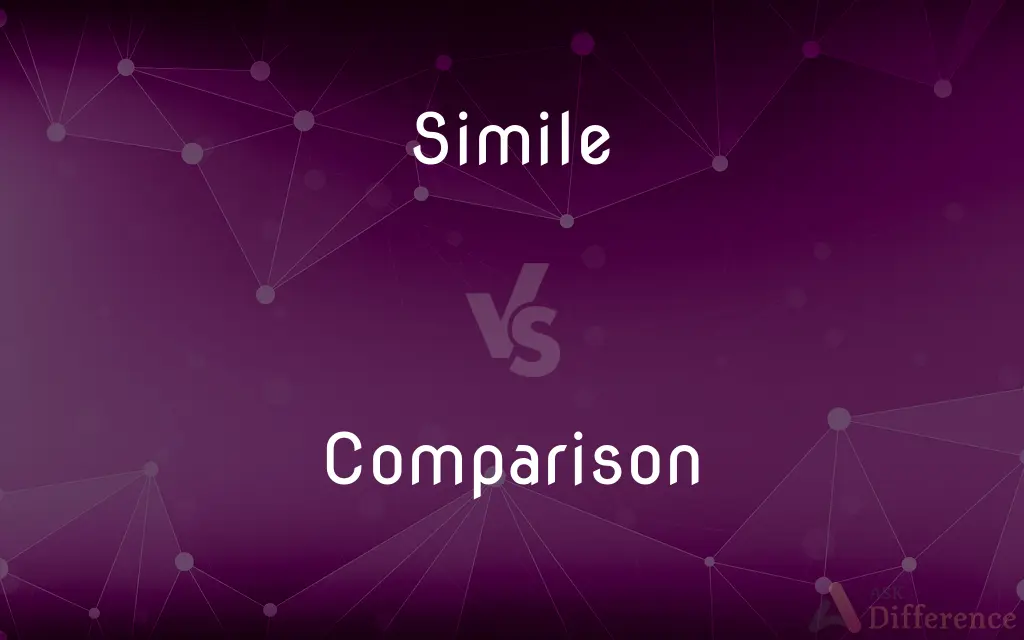Simile vs. Comparison — What's the Difference?
By Tayyaba Rehman & Urooj Arif — Updated on March 10, 2024
A simile explicitly uses "like" or "as" to compare two things, while comparison broadly assesses similarities or differences.

Difference Between Simile and Comparison
Table of Contents
ADVERTISEMENT
Key Differences
A simile is a figure of speech that explicitly compares two different things by using connecting words such as "like" or "as." For example, saying "Her smile is like sunshine" uses a simile to liken a smile to sunshine, emphasizing its brightness and warmth. Comparison, on the other hand, is a broader term that involves identifying similarities and/or differences between two or more items, concepts, or situations. It does not necessarily use "like" or "as" and can be used for a wide range of purposes, including analysis, evaluation, and explanation.
While similes are primarily used for embellishment and creating vivid imagery in language, comparisons serve a more analytical or evaluative function, helping to understand, contrast, and assess the qualities or characteristics of the subjects involved. Comparisons can be made in a straightforward manner without the need for figurative language.
Similes are a subset of metaphors, which are also comparisons but do not use "like" or "as." Similes maintain the distinct identities of the compared objects, whereas metaphors might suggest a more direct equivalence. Comparisons, more broadly, can include both simile and metaphor as well as other forms of comparative analysis.
In summary, similes are a specific type of comparison that uses "like" or "as" to create vivid imagery or express ideas creatively. Comparisons, in general, involve analyzing and evaluating similarities and differences between entities for various purposes, not necessarily employing figurative language.
Comparison Chart
Definition
A figure of speech comparing two different things using "like" or "as."
The act of assessing similarities and/or differences between two or more entities.
ADVERTISEMENT
Purpose
To create vivid imagery or express an idea more creatively.
To analyze, evaluate, or understand the qualities or characteristics of subjects.
Language
Uses connecting words like "like" or "as."
Does not necessarily use specific connecting words.
Scope
A form of figurative language.
Can include both figurative and literal analysis.
Example
"He fights like a lion" uses a simile.
Comparing two novels to discuss thematic similarities and differences.
Compare with Definitions
Simile
Used to create a vivid imagery or express ideas in a more imaginative way.
His words were as sharp as a knife.
Comparison
The act of evaluating two or more items to identify similarities and differences.
A comparison of 19th and 20th-century art reveals evolving styles.
Simile
A figure of speech that makes a comparison, showing similarities between two different things using "like" or "as."
She danced like a leaf on the wind.
Comparison
Can be used in various contexts, including literature, science, and daily decision-making.
Comparing nutritional labels helps choose healthier food options.
Simile
Often found in literature, poetry, and everyday language.
Quiet as a mouse, she slipped out of the room.
Comparison
Does not necessarily employ figurative language like similes or metaphors.
A technical comparison of two smartphones might focus on battery life and processing power.
Simile
Helps to make descriptions more expressive and engaging.
He is as brave as a lion.
Comparison
Comparisons are fundamental in critical thinking and analysis.
Comparing different management theories can reveal their practical applications in business.
Simile
Similes add depth and detail to writing by drawing parallels.
Her laughter was like music to his ears.
Comparison
Serves a broader analytical or evaluative purpose beyond creating imagery.
Through comparison, one can appreciate the unique qualities of each author's writing style.
Simile
A simile () is a figure of speech that directly compares two things. Similes differ from other metaphors by highlighting the similarities between two things using comparison words such as "like", "as", "so", or " than", while other metaphors create an implicit comparison (i.e.
Comparison
The act of comparing or the process of being compared.
Simile
A figure of speech in which two essentially unlike things are compared, often in a phrase introduced by like or as, as in "How like the winter hath my absence been" or "So are you to my thoughts as food to life" (Shakespeare).
Comparison
A statement or estimate of similarities and differences.
Simile
A figure of speech in which one thing is explicitly compared to another, using e.g. like or as.
Figure of speech
Comparison
The quality of being similar or equivalent; likeness
No comparison between the two books.
Simile
A word or phrase by which anything is likened, in one or more of its aspects, to something else; a similitude; a poetical or imaginative comparison.
A good swift simile, but something currish.
Comparison
(Grammar) The modification or inflection of an adjective or adverb to denote the positive, comparative, and superlative degrees, as in English, along with the equative degree in certain other languages, such as Irish Gaelic.
Simile
A figure of speech that expresses a resemblance between things of different kinds (usually formed with `like' or `as')
Comparison
The act of comparing or the state or process of being compared.
To bring a thing into comparison with another;
There is no comparison between them
Comparison
An evaluation of the similarities and differences of one or more things relative to some other or each other.
He made a careful comparison of the available products before buying anything.
Comparison
With a negation, the state of being similar or alike.
There really is no comparison between the performance of today's computers and those of a decade ago.
Comparison
(grammar) A feature in the morphology or syntax of some languages whereby adjectives and adverbs are inflected to indicate the relative degree of the property they define exhibited by the word or phrase they modify or describe.
In English, adjectives and adverbs have three forms when making a comparison: the plain form "hot", the comparative form "hotter", and the superlative form "hottest".
Comparison
That to which, or with which, a thing is compared, as being equal or like; illustration; similitude.
Comparison
(rhetoric) A simile.
Comparison
(phrenology) The faculty of the reflective group which is supposed to perceive resemblances and contrasts.
Comparison
The act of comparing; an examination of two or more objects with the view of discovering the resemblances or differences; relative estimate.
As sharp legal practitioners, no class of human beings can bear comparison with them.
The miracles of our Lord and those of the Old Testament afford many interesting points of comparison.
Comparison
The state of being compared; a relative estimate; also, a state, quality, or relation, admitting of being compared; as, to bring a thing into comparison with another; there is no comparison between them.
Comparison
That to which, or with which, a thing is compared, as being equal or like; illustration; similitude.
Whereto shall we liken the kingdom of God? Or with what comparison shall we compare it?
Comparison
The modification, by inflection or otherwise, which the adjective and adverb undergo to denote degrees of quality or quantity; as, little, less, least, are examples of comparison.
Comparison
A figure by which one person or thing is compared to another, or the two are considered with regard to some property or quality, which is common to them both; e.g., the lake sparkled like a jewel.
Comparison
The faculty of the reflective group which is supposed to perceive resemblances and contrasts.
Comparison
To compare.
Comparison
Examining resemblances or differences
Comparison
Relation based on similarities and differences
Comparison
Qualities that are comparable;
No comparison between the two books
Beyond compare
Common Curiosities
Are comparisons always objective?
Comparisons can be objective when based on factual data, but subjective elements can enter, especially in areas like art or personal preference.
Can a simile be considered a type of comparison?
Yes, similes are a specific type of figurative comparison that uses "like" or "as" to draw parallels between different things.
How do similes differ from general comparisons?
Similes specifically use "like" or "as" for creative or vivid comparisons, whereas general comparisons assess similarities and differences more broadly, not necessarily in a figurative sense.
What does comparison mean?
Comparison involves evaluating two or more entities to identify their similarities and differences, used in various analytical and evaluative contexts.
What is the purpose of making comparisons?
The purpose of making comparisons is to analyze, evaluate, understand, or make decisions based on the assessment of similarities and differences.
Is a metaphor the same as a simile?
Metaphors and similes both make comparisons, but metaphors do so directly without "like" or "as," often implying that one thing is another.
Can comparisons be made without using "like" or "as"?
Yes, comparisons can be made directly by stating similarities and differences without the need for connecting words like "like" or "as."
Are similes always easy to identify?
Similes are generally easy to identify due to the use of "like" or "as," but some may be more subtle or embedded in complex language.
How do comparisons contribute to critical thinking?
Comparisons foster critical thinking by requiring evaluation, discernment, and synthesis of information to understand or make judgments.
What is a simile?
A simile is a figure of speech that makes a direct comparison between two unlike things using "like" or "as" to highlight similarities.
Why are similes used in literature?
Similes enhance descriptive writing, add depth to characters and settings, and engage the reader's imagination by creating vivid imagery.
Can a comparison be both positive and negative?
Yes, comparisons can highlight both positive and negative aspects, depending on the characteristics being evaluated.
Do similes and comparisons always involve two subjects?
While they often involve two subjects, similes and comparisons can involve multiple entities, especially in broader analytical contexts.
How does context affect the use of similes and comparisons?
The context, such as literary, academic, or everyday conversation, determines the appropriateness and type of similes or comparisons used.
Can comparisons be used in scientific research?
Yes, comparisons are fundamental in scientific research for hypothesis testing, data analysis, and drawing conclusions from experiments.
Share Your Discovery

Previous Comparison
Del vs. Nabla
Next Comparison
Alchemist vs. ChemistAuthor Spotlight
Written by
Tayyaba RehmanTayyaba Rehman is a distinguished writer, currently serving as a primary contributor to askdifference.com. As a researcher in semantics and etymology, Tayyaba's passion for the complexity of languages and their distinctions has found a perfect home on the platform. Tayyaba delves into the intricacies of language, distinguishing between commonly confused words and phrases, thereby providing clarity for readers worldwide.
Co-written by
Urooj ArifUrooj is a skilled content writer at Ask Difference, known for her exceptional ability to simplify complex topics into engaging and informative content. With a passion for research and a flair for clear, concise writing, she consistently delivers articles that resonate with our diverse audience.














































